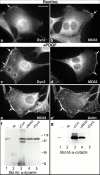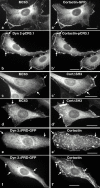Regulated interactions between dynamin and the actin-binding protein cortactin modulate cell shape
- PMID: 11018064
- PMCID: PMC2189798
- DOI: 10.1083/jcb.151.1.187
Regulated interactions between dynamin and the actin-binding protein cortactin modulate cell shape
Abstract
The dynamin family of large GTPases has been implicated in the formation of nascent vesicles in both the endocytic and secretory pathways. It is believed that dynamin interacts with a variety of cellular proteins to constrict membranes. The actin cytoskeleton has also been implicated in altering membrane shape and form during cell migration, endocytosis, and secretion and has been postulated to work synergistically with dynamin and coat proteins in several of these important processes. We have observed that the cytoplasmic distribution of dynamin changes dramatically in fibroblasts that have been stimulated to undergo migration with a motagen/hormone. In quiescent cells, dynamin 2 (Dyn 2) associates predominantly with clathrin-coated vesicles at the plasma membrane and the Golgi apparatus. Upon treatment with PDGF to induce cell migration, dynamin becomes markedly associated with membrane ruffles and lamellipodia. Biochemical and morphological studies using antibodies and GFP-tagged dynamin demonstrate an interaction with cortactin. Cortactin is an actin-binding protein that contains a well defined SH3 domain. Using a variety of biochemical methods we demonstrate that the cortactin-SH3 domain associates with the proline-rich domain (PRD) of dynamin. Functional studies that express wild-type and mutant forms of dynamin and/or cortactin in living cells support these in vitro observations and demonstrate that an increased expression of cortactin leads to a significant recruitment of endogenous or expressed dynamin into the cell ruffle. Further, expression of a cortactin protein lacking the interactive SH3 domain (CortDeltaSH3) significantly reduces dynamin localization to the ruffle. Accordingly, transfected cells expressing Dyn 2 lacking the PRD (Dyn 2(aa)DeltaPRD) sequester little of this protein to the cortactin-rich ruffle. Interestingly, these mutant cells are viable, but display dramatic alterations in morphology. This change in shape appears to be due, in part, to a striking increase in the number of actin stress fibers. These findings provide the first demonstration that dynamin can interact with the actin cytoskeleton to regulate actin reorganization and subsequently cell shape.
Figures







Similar articles
-
Regulation of cortactin/dynamin interaction by actin polymerization during the fission of clathrin-coated pits.J Cell Sci. 2005 Feb 15;118(Pt 4):807-17. doi: 10.1242/jcs.01668. Epub 2005 Jan 25. J Cell Sci. 2005. PMID: 15671060
-
Cortactin is a component of clathrin-coated pits and participates in receptor-mediated endocytosis.Mol Cell Biol. 2003 Mar;23(6):2162-70. doi: 10.1128/MCB.23.6.2162-2170.2003. Mol Cell Biol. 2003. PMID: 12612086 Free PMC article.
-
Fgd1, the Cdc42 GEF responsible for Faciogenital Dysplasia, directly interacts with cortactin and mAbp1 to modulate cell shape.Hum Mol Genet. 2003 Aug 15;12(16):1981-93. doi: 10.1093/hmg/ddg209. Hum Mol Genet. 2003. PMID: 12913069
-
The role of the PH domain and SH3 binding domains in dynamin function.Cell Signal. 1997 Sep;9(6):395-401. doi: 10.1016/s0898-6568(97)00041-7. Cell Signal. 1997. PMID: 9376220 Review.
-
Dynamin at the actin-membrane interface.Curr Opin Cell Biol. 2003 Feb;15(1):31-9. doi: 10.1016/s0955-0674(02)00010-8. Curr Opin Cell Biol. 2003. PMID: 12517701 Review.
Cited by
-
Drosophila king tubby (ktub) mediates light-induced rhodopsin endocytosis and retinal degeneration.J Biomed Sci. 2012 Dec 10;19(1):101. doi: 10.1186/1423-0127-19-101. J Biomed Sci. 2012. PMID: 23228091 Free PMC article.
-
A dynamin-cortactin-Arp2/3 complex mediates actin reorganization in growth factor-stimulated cells.Mol Biol Cell. 2003 Mar;14(3):1085-96. doi: 10.1091/mbc.e02-08-0466. Mol Biol Cell. 2003. PMID: 12631725 Free PMC article.
-
Activity-dependent redistribution and essential role of cortactin in dendritic spine morphogenesis.J Neurosci. 2003 Dec 17;23(37):11759-69. doi: 10.1523/JNEUROSCI.23-37-11759.2003. J Neurosci. 2003. PMID: 14684878 Free PMC article.
-
Distinct dynamics of endocytic clathrin-coated pits and coated plaques.PLoS Biol. 2009 Sep;7(9):e1000191. doi: 10.1371/journal.pbio.1000191. Epub 2009 Sep 8. PLoS Biol. 2009. PMID: 19809571 Free PMC article.
-
Cortactin: A Major Cellular Target of the Gastric Carcinogen Helicobacter pylori.Cancers (Basel). 2020 Jan 9;12(1):159. doi: 10.3390/cancers12010159. Cancers (Basel). 2020. PMID: 31936446 Free PMC article. Review.
References
Publication types
MeSH terms
Substances
LinkOut - more resources
Full Text Sources
Molecular Biology Databases
Miscellaneous

